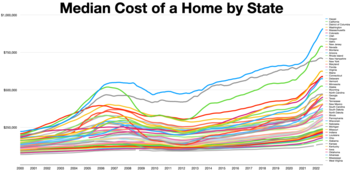
Back الفقاعة الإسكانية في الولايات المتحدة Arabic Στεγαστική φούσκα (ΗΠΑ) Greek Burbuja inmobiliaria de los Estados Unidos Spanish حباب مسکن ایالات متحده در دهه ۲۰۰۰ Persian Bulle immobilière américaine des années 2000 French בועת הנדל"ן בארצות הברית HE



| Part of a series on the |
| Great Recession |
|---|
| Timeline |
The 2000s United States housing bubble or house price boom or 2000s housing cycle[2] was a sharp run up and subsequent collapse of house asset prices affecting over half of the U.S. states. In many regions a real estate bubble, it was the impetus for the subprime mortgage crisis. Housing prices peaked in early 2006, started to decline in 2006 and 2007, and reached new lows in 2011.[3] On December 30, 2008, the Case–Shiller home price index reported the largest price drop in its history.[4] The credit crisis resulting from the bursting of the housing bubble is an important cause of the Great Recession in the United States.[5]
Increased foreclosure rates in 2006–2007 among U.S. homeowners led to a crisis in August 2008 for the subprime, Alt-A, collateralized debt obligation (CDO), mortgage, credit, hedge fund, and foreign bank markets.[6] In October 2007, Henry Paulson, the U.S. Secretary of the Treasury, called the bursting housing bubble "the most significant risk to our economy".[7]
A bubble had the potential to affect not only on home valuations, but also mortgage markets, home builders, real estate, home supply retail outlets, Wall Street hedge funds held by large institutional investors, and foreign banks, increasing the risk of a nationwide recession.[8][9][10][11] Concerns about the impact of the collapsing housing and credit markets on the larger U.S. economy caused President George W. Bush and the Chairman of the Federal Reserve Ben Bernanke to announce a limited bailout of the U.S. housing market for homeowners who were unable to pay their mortgage debts.[12]
In 2008 alone, the United States government allocated over $900 billion (~$1.25 trillion in 2023) to special loans and rescues related to the U.S. housing bubble. This was shared between the public sector and the private sector. Because of the large market share of Federal National Mortgage Association (Fannie Mae) and the Federal Home Loan Mortgage Corporation (Freddie Mac) (both of which are government-sponsored enterprises) as well as the Federal Housing Administration, they received a substantial share of government support, even though their mortgages were more conservatively underwritten and actually performed better than those of the private sector.[13]
- ^ Cite error: The named reference
IE2was invoked but never defined (see the help page). - ^ Chodorow-Reich, Gabriel; Guren, Adam M.; McQuade, Timothy J. (October 2022). "The 2000s Housing Cycle With 2020 Hindsight: A Neo-Kindlebergerian View" (PDF).
- ^ "S&P CoreLogic Case-Shiller Home Price Indices - S&P Dow Jones Indices". standardandpoors.com. Archived from the original on May 22, 2013. Retrieved October 5, 2017.
- ^ Mantell, Ruth. "Home prices off record 18% in past year, Case-Schiller says". marketwatch.com. Retrieved April 29, 2009.
- ^ Holt, Jeff. "A Summary of the Primary Causes of the Housing Bubble and the Resulting Credit Crisis: A Non-Technical Paper" (PDF). 2009, 8, 1, 120-129. The Journal of Business Inquiry. Archived from the original (PDF) on October 17, 2014. Retrieved February 15, 2013.
- ^ "In Washington, big business and big money are writing the rules on trade ...". Bill Moyers Journal. June 29, 2007. PBS.
- ^ "Housing woes take bigger toll on economy than expected: Paulson". AFP. October 17, 2007. Archived from the original on September 18, 2010.
- ^ Cite error: The named reference
WeekStd bubble troublewas invoked but never defined (see the help page). - ^ Cite error: The named reference
CFC warningwas invoked but never defined (see the help page). - ^ Cite error: The named reference
Roubini free fallwas invoked but never defined (see the help page). - ^ Cite error: The named reference
RGE tramp stampwas invoked but never defined (see the help page). - ^ Solomon, Deborah (August 31, 2007). "Bush Moves to Aid Homeowners". The Wall Street Journal.
- ^ Reuters. (2008). FACTBOX – U.S. government bailout tally tops 504 billion pounds.
© MMXXIII Rich X Search. We shall prevail. All rights reserved. Rich X Search